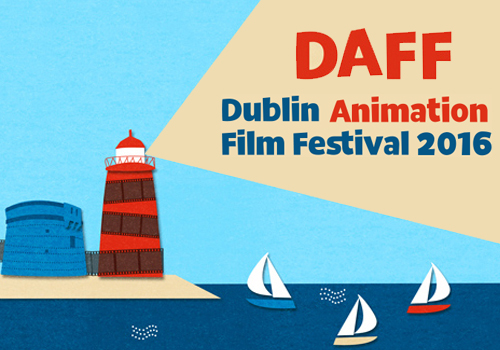It makes sense for Dublin to have a film festival dedicated to animation. With Irish studios like Cartoon Saloon, Brown Bag and Boulder Media achieving worldwide success on both big and small screens, the Dublin Animation Film Festival (DAFF) is a platform dedicated to highlighting these successes, and to point the way to success in the future.
October 22nd saw the 6th festival take place in Dun Laoghaire’s Pavilion Theatre. Though still just a one-day festival, DAFF has grown considerably over its six years under the guidance of festival director Fionnghuala Ni Neill. In its biggest programme yet, the festival screened a number of shorts from Ireland and abroad, and recognizes the efforts with a number of prizes and awards. Among the prizes given this year was an honourary award to this year’s special guest, Duke Johnson. At the same time last year, Johnson was in the middle of an extensive run of film festivals to promote Anomalisa, his collaboration with Charlie Kaufman that garnered critical acclaim and earned an Academy Award nomination for Best Animated Feature.
Securing Johnson is quite an achievement for a small festival like DAFF but, like all festivals, it all starts with the people on the ground. We arrive at the Pavilion on a cloudy Saturday morning to find a number of volunteers in the lobby, some discussing ticketing, others moving items of furniture. Fionnuaghla is there to greet us, and thanks us for covering the festival. It may not have red carpet glitz, but DAFF has a sense of purpose in showcasing upcoming talent. It’s a purpose driven by its volunteers, who busily mill and prepare about the theatre ahead of their noon start.
Just then, Johnson arrives with his publicist. We’re introduced, shake hands, and are directed to a dressing room (It is a theatre, after all) for our talk. The 37-year-old writer/director is a keen talker. A mention of Irish animated successes like Song of The Sea or The Secret of Kells prompts an enthusiastic response (“I love those movies!”). However, given the young upcoming talent that DAFF will showcase, it seems fitting to start our chat proper with Johnson’s own film school experiences. As so often happens, he fell into animation through a combination of chance and necessity: “I went to film school at NYU. I took an animation course while I was there, but I intended to pursue live-action filmmaking, and I couldn’t make that work in New York, post graduation, so I ended up going to grad school in Los Angeles at the American Film Institute. I made a live action thesis film, and I invited a friend of mine, Dino Stamatopoulos, who’s a writer and creator, and had created the TV show Moral Orel, which is an animated show that loosely parodies the classic Davey and Goliath TV show, at least aesthetically.”
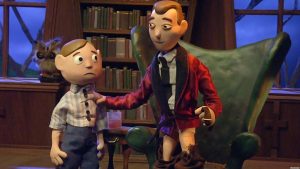
Stamatopoulos will crop up a few times as we go on. Bringing Johnson onto his scathing Adult Swim satire Moral Orel proved a formative experience for the young director. “I was just anxious to direct, so I said ‘OK’ to Dino. Moral Orel was in the second season then, so Dino said if it gets a third season, I could do an episode. So, I spent the next year and a half following him around and hanging out at the studio every afternoon, learning about and falling in love with the process.” Johnson was enamoured with the greater degree of control animation offered: “If you’re a filmmaker of any kind, it’s easy to fall in love with that process because it’s film sets, but shrunken down. You see it as like a diagram of a real set, and you get to hold these small things and put them wherever you want, and really control the space and blocking. It’s the highest level of control you can have, I think, in filmmaking.”
The control appealed to Johnson, though Moral Orel was very much Stamatopoulos’ project. “When I came onto the show,” Johnson explains, “it was already in the third season, so the look was already developed. The approach had a lot to do with Dino’s childhood, and his relationship with religion, so it’s personal to him. Because I wasn’t involved from a development standpoint, I approached it purely directorially, just trying to sell the jokes.” In its tale of a naive 12-year-old facing the world’s wrongs with religious goodwill, a large part of Moral Orel’s humour depended on a combination of satire of, and nostalgia for, Davey and Goliath. “There was something about Davey and Goliath’s aesthetic, in that it looked really bad. But a lot of people like the way it looked, because it had a nostalgic quality. It reminds them of a certain time period, but if you look at it now, it’s rough. Dino wanted Moral Orel to look bad in the beginning, in a sense. As it got more and more seasons, and it evolved into a more subversive and more adult kind of thing, the aesthetic improved and the production values went up. The [characters’] movements became more naturalistic over time, and it evolved into its own thing, even though it started originally as a parody.”
Alas, improved production values can’t compensate when the material bites a little too hard for some. Johnson explains, “Moral Orel got cancelled after its third season, really because..” Johnson can’t help but laugh. “Dino’s style is this really dark, gut-wrenching authentic kind of thing that he’s going for, this kind of emotional authenticity that you don’t typically seen in Adult Swim animated shows. That’s his style and humour and what interests him, so we probably pushed Moral Orel a little too far for the network, so they cancelled the show.” Still, as innocent little Orel would probably put it, God never closes a door without opening a window. “Dino had a strong relationship with the network, and everyone loves his style and writing, so they gave him another show. They asked him, ‘What would you want to do if it was something else?’, and he came up with Mary Shelley’s Frankenhole.”
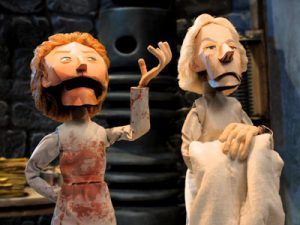
Mary Shelley’s Frankenhole sees an immortal Victor Frankenstein time-travelling around the world to continue his ghoulish experiments. Once again, it was a show driven by a nostalgic love. “Dino was a fan of classic Universal monsters. We developed that show with very little budget, so we were trying to create an aesthetic that articulated the style of comedy, while looking monster-y. There’s a lot of German Expressionism in there. Doing it on a budget, we were very influenced by the Thai paper cut-out puppets, that paper aesthetic with flapper mouths.”
Whilst money shouldn’t hamper your artistic ideas, Johnson explains that restrictions led to something bigger and better coming along. “We were trying to make Frankenhole, but we were working with another studio, and it was harder to make this low-budget show with the studio because they took production fees and stuff. So, we thought ‘What if we started our own studio, where we could put all the money into the product, and make the best show that we could?’
So, how does one go about starting a studio? As Johnson explains, it only takes an opportunity. “We didn’t know how to [start a studio], but then Dino’s friend Dan Harmon, who had a show on NBC called Community, was going to do an animated episode. Dino pitched him a stop-motion episode, and if it’s stop motion, it’s gonna be Christmas and it’s gonna be directed by me. So now, we had a larger budget for a single episode of a major network show, and we used that opportunity to start Starburns Industries.”
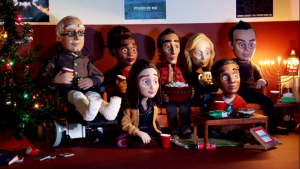
The Christmas special of Community’s second season, ‘Abed’s Uncontrollable Christmas’ couldn’t have been a better launching pad. Johnson recalls, “We made the Community Christmas special as the studio’s first thing, and that was a hit for us. It was a big deal, a lot of people saw it and it got a lot of press. It won an animation Emmy, and so it kind of got us started. And then we did another season of Frankenhole, on our own with a much higher level of production values than the first season.” Starburns Industries continues to enjoy success with commercials, short films and the continuing exploits of Rick and Morty. But how did Johnson and the studio leap from an episode of Community to Anomalisa? Did Charlie Kaufman just call up one day for a chat?
The short answer? “It didn’t really happen like that!” As Johnson explains, “Now we had this studio that we had to keep the lights on, and we’re like ‘Oh, no! What do we do?’ There’s down time between seasons of shows, so we all met in Dino’s office to discuss what we could produce or try to find money for. We’re pitching ideas back and forth, and then out of the blue Dino says, ‘Well, I have this Charlie Kaufman script.’” It must be tough to hold your tongue when you’re told something like that. “I say, ‘What the hell are you talking about? Are you out of your mind? How do I not know this?!’
Like Community’s Christmas episode, it was a chance based on a friendship. “It turns out Dino and Charlie were friends, and they actually wrote together on The Dana Carvey Show in the ‘90s, and had maintained a friendship.” It seems odd that Kaufman, now regarded as a master of existentialist dread with scripts such as Adaptation. and Synecdoche, New York to his name, started out in sitcoms, but then all his works come with certain sense of humour and playfulness. Anomalisa was no different, emerging from The Theater of the New Ear, a project Kaufman produced with the Coen brothers and composer Carter Burwell in Los Angeles in April 2005. The double-billed play was performed in the style of an old radio serial, using foley artists and live score, but no costumes or sets.
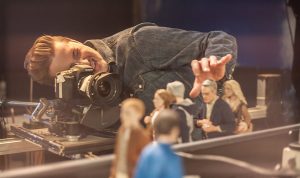
So how did Stamatopoulos come to have the script? “Dino loved the play, and had asked Charlie for a copy of the script, just to read for his own pleasure. He got his copy, and let me read it. I was a huge fan of Charlie’s, and I read it and thought ‘I’ve never seen anything like this in animation. Could we do this?’ So Dino reached out to Charlie, and asked ‘Could we make it as a stop motion thing?’, and so we all got together and just started talking about it. Charlie said, “Alright, if you can get the money to do it, we’ll do it.” Unlike before, money wasn’t a problem.
The problem in adapting Anomalisa was figuring out how to translate that specific experience of the play onto film. On the one hand, it’s a simple tale of urban malaise set in a hotel. On the other, it has specific challenges. Every character, bar the two leads, is played by one person (Tom Noonan). To Johnson, the answer was to maintain as much of the play’s essence as possible. “It’s the same cast as the play (Noonan, David Thewlis and Jennifer Jason Leigh). The Theatre of the New Ear was a unique theatrical experience, where it was almost like a radio play, with a foley artist, live sound effects and things. It was just the actors on stage reading their lines. Yet, it was a visual experience because there was an audience watching this happen. The way it was structured meant there was a contrast between what they were seeing and what they were hearing. When we did Anomalisa, we had to figure out the challenge of taking this thing that intended for a very specific exhibition, and visualising everything without that contrast.
The design was key to achieving that effect. Anomalisa nails the ennui and sameness of hotels, right down to the little details. Keen to give credit where it’s due, Johnson explains, “A lot was in the writing. Charlie was drawing of his own experiences of travelling and staying in hotels while working in the film industry. I actually went and stayed in a hotel; not like I’d never been in one before! Specifically, I went to a hotel that felt like one in the movie. I stayed there overnight and took pictures of everything: where the smoke detectors are, where the air vents are, what kind of little cards they have that talk about conserving energy and where to put your towel to replace it. All these little details, the coffee maker and all that stuff.” These are details we’ve all noticed in hotels, and Anomalisa’s Fregoli Hotel has them all. “I photographed that, and our intention was to make it feel specific but, at the same time, have that feeling like ‘I’ve stayed in that hotel room’”
Johnson shared the directing credit on Anomalisa with Kaufman. Johnson describes a very harmonious working process. “We just did everything together. From the very beginning, talking about how this thing would be visualised and developing the aesthetic. We spent a lot of the time on the phone, just endless phone conversations about artistic references and sculptors and painters and other films, and sending references back and forth, and it started to take shape.”
They started with the basics. “We started first with the character designs, and just going down the traditional route of having designers do sketches, and saying ‘This kind of looks like every other animated feature we’ve ever seen. This doesn’t feel right.’ Then it’s pictures of real people, and translating them in sculptures, and then making subtle adjustments based on practical things you have to do in animation, and then also what kind of animation we want and what we want it to look like, the level of the emotional experience we want to get on the faces. That leads us to 3D printing, and then the replacement faces, and what does that look like with the line across the face.” Seamless as it may seem, Anomalisa is full of little details to remind us of the animation, and that’s purposeful. Johnson notes, “People say ‘We can fix that in post’, but we say ‘What if we don’t?’. It just started developing around these conversations, trials and errors.”
Johnson has come to the end of a whirlwind year with Anomalisa, so we’re keen to hear what comes next. “I still work actively as the creative director at Starburns,” he explains “and we have a lot going on, particularly in 2D animation at the moment. But the next film I’m intending to do is live action. It’s something I’m writing myself, not a lot to say about it right now. I hope it’ll be good!” That’s as much as we can get out of him on that project, except for what he hopes to bring to it from his animated experiences. “It’s been an interesting experience for me, going from live action to animation, and how one influenced the other. I brought on a live action cinematographer, so the way we approached the light was very much from a live action point of view, particularly on Anomalisa. It’s lit very similarly to how you would light a live action film. And now, going back into live action, I’m taking a lot of the tools that I’ve learned and developed in animation and applying them to the live action. A lot of the pre-production and pre-planning that’s done in animation, I’d like to adapt them to live action. There’s a lot of crossover.”
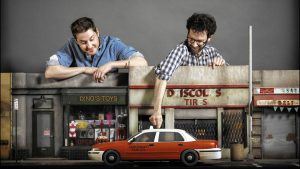
There may be a lot of crossover, but is there anything specific that either live action or animation has over the other? “There’s many things you can do in animation you can’t do in live action, and vice versa, but it’s just different. It’s the difference between taking a photograph and painting a portrait in oils.” Like the joins in Anomalisa’s character’s faces, it’s a conscious decision to choose animation. “When Anomalisa came out, a lot of people asked ‘Why didn’t you just do this in live action?’ You don’t say to a painter ‘Why didn’t you just take a photograph of that person?’ The process of seeing this story through the filter of animation infuses it with something specific and unique. You can feel the impact of the creators and animators, which says something thematically about what’s happening.” It all comes back to the control Johnson values as a director. Controlling every aspect allows specificity in the story and the message.
He enthuses further, “Also, these interactions between the characters take on a new meaning in animation. It focuses the audience’s attention on specific things that might be taken for granted or overlooked in live action. But now, these subtle, human movements and interactions are infused with a new sense of purpose and awareness that everything you do in animation is intentional, and someone had to make these choices. They have their own feeling and impact, but it’s all storytelling, just different mediums.” These are the words of a man who loves his craft. With an eye on the clock, we wrap up at that point, and step out of the dressing room to the lobby once more. As goodbyes are said, the lobby is filling with young students, all filled with the same enthusiasm for their chosen medium. As evidenced by both the festival’s attendees and its special guest, animation is very much alive.

